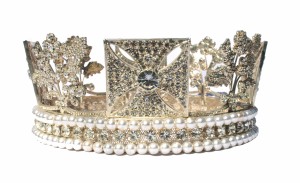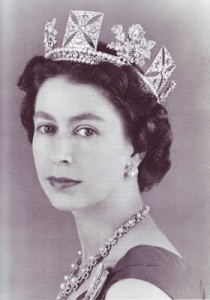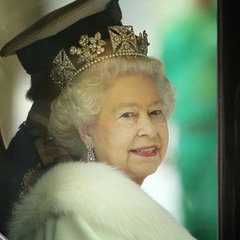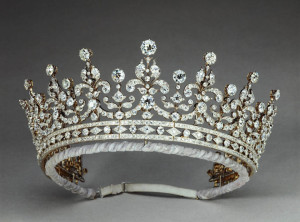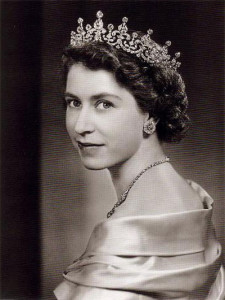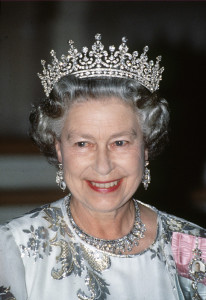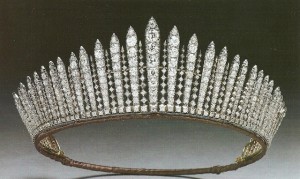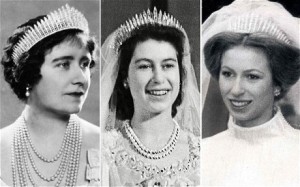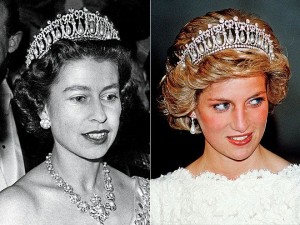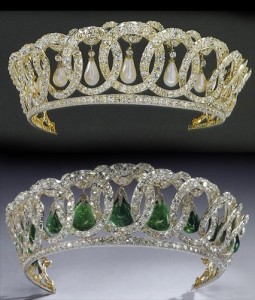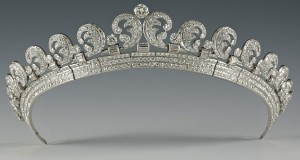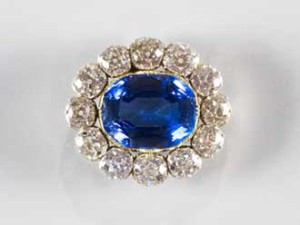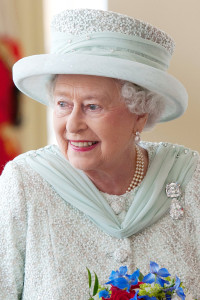The current British Monarch, Queen Elizabeth II, has an extensive collection of tiaras, necklaces, earrings and brooches that are part of her personal collection. Most of these items have been acquired and passed down through previous members of the royal family. The Queen’s Jewelry Collection Part One featured such items as the George IV State Diadem, Queen Mary’s Fringe Tiara, Cambridge Lover’s Knot Tiara and the Cartier Halo Tiara, which was worn by Katherine Middleton when she married Prince William in 2011, and also the Prince Albert Sapphire Brooch and the Cullinan III & IV Diamonds that the Queen appropriately wore for her Diamond Jubilee in 2013. (For more information on these beautiful tiaras and brooches, please click on the link)
In this post, I will discuss several additional pieces from the Queen’s Jewelry Collection.
Queen Victoria’s Golden Jubilee Necklace
In 1887, to mark the fiftieth anniversary of Queen Victoria’s accession to the British throne, a committee was formed to raise funds for a commemorative statue of Prince Albert to honor the beloved husband of the Queen who died in 1861. (Eventually the completed statue was dedicated in 1890 at Windsor) The remainder of the fund was used for an impressive necklace with 26 large pearls and over 300 diamonds which Queen Victoria wore in the official Golden Jubilee photograph. The necklace has a large central pearl and diamond quatrefoil with a large pearl in the middle, a pearl and diamond crown set at the top with a large pearl drop hanging at the bottom. The remaining necklace comprises of graduated diamond and pearl trefoil links, six of the largest trefoils were designed to be worn separately as brooches. After Queen Victoria’s death in 1901, the necklace became the personal property of the crown and was worn infrequently by subsequent queen consorts. The necklace is said to be a favorite of the current Queen Elizabeth II.
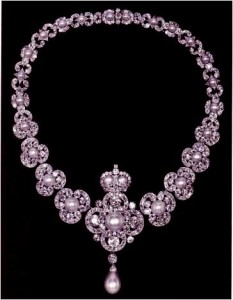
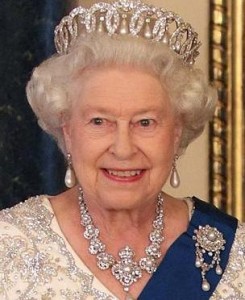
Queen Alexandra’s Dagmar Necklace
Another remarkable necklace in the Queen’s personal jewelry collection is known as the Dagmar Necklace which was given by King Frederik VII of Denmark to Princess (later Queen) Alexandra upon her marriage to the Prince of Wales (later King Edward VII) in 1863. The necklace was designed in a Byzantine style comprising of alternating diamond and pearls swags set in gold connected with diamond and pearl medallions also set in gold and features a replica of the famous Dagmar Cross, hence the name of the necklace. The history is that Queen Dagmar was buried with a similar cross laid on her breast and since then the tradition is that when Danish princesses are married they wear a replica of the cross. The Byzantine style cross on the necklace is detachable with an image of Christ at the center with four additional saintly images on the front while the back depicts a scene from the Crucifixion, included within the cross is a piece of silk from the grave of King Canute and a sliver of wood from the original Dagmar Cross. Upon the death of Queen Alexandra in 1925, the necklace was given to the Crown eventually passing to Queen Elizabeth II; she appropriately wore the necklace on her state visit to Denmark in 1957.
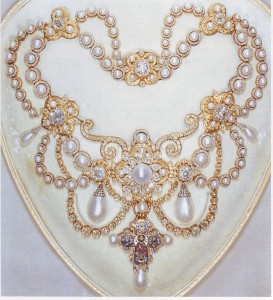
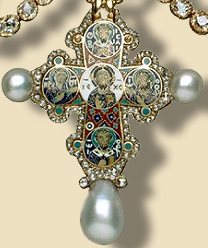
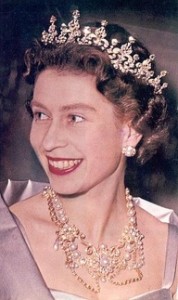
King George VI Sapphire Necklace
The sapphire necklace is part of the King George VI Sapphire Suite which was given by King George VI as a wedding present for his daughter, Princess Elizabeth (the future Queen Elizabeth II) when she married Prince Phillip in 1947. The suite was originally created in 1850 and includes a necklace links of oblong sapphires surrounded by diamonds and a matching pair of oblong sapphire earrings also surrounded with diamonds. In 1959, Princess Elizabeth had the necklace shortened and the large center sapphire made into a drop pendant which could also be detached from the necklace to use as a separate brooch. Later in 1963, Queen Elizabeth commissioned a new sapphire and diamond tiara and bracelet from sapphires that once belonged to Princess Louise of Belgium.
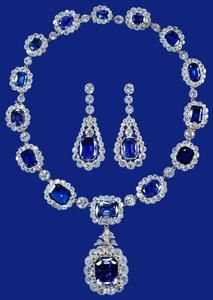
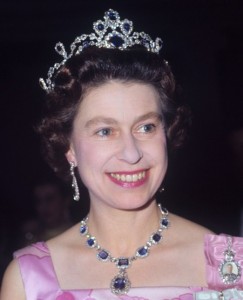
Kensington Bow Brooch
The Kensington Bow Brooch was inherited by Queen Elizabeth from the large jewelry collection of her maternal grandmother, Queen Mary. The brooch was a gift to mark the 1893 wedding of Princess May of Teck (the future Queen Mary) to the Duke of York (the future King George V) She wore the brooch at both the coronations of King Edward VII (her father-in-law) and King George V (her husband) The brooch was made by Collingwood & Co. with two rows of diamonds set in silver and gold to resemble a bow tied around a single large diamond in the center with a detachable pave set baroque pearl pendant. Queen Elizabeth inherited the brooch in 1953 and often wears it to secure a sash at her shoulder for formal events and has infrequently worn it without the pearl drop for more casual day appearances. Most recently the Queen wore the Kensington Bow Brooch at the funeral of her mother, Queen Elizabeth the Queen Mother, who died in 2002.
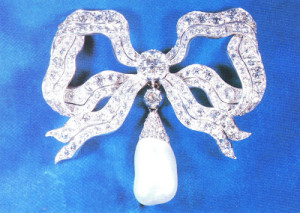
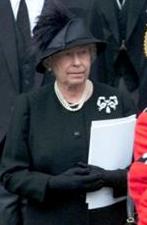
Cartier Clips
In the 1930s the French jeweler, Louis Cartier, started designing matching brooches that could be worn together to form one large jewelry accessory or separately as single brooches. Princess Elizabeth was given a set of Cartier Clips as an 18th birthday gift from her parents in 1944. The brooches are designed in an Art Deco style with 20 oval and 22 baguette aquamarines and 38 round diamonds. The pair of Cartier Clips are among Queen Elizabeth’s favorites and she has worn them frequently throughout the years.
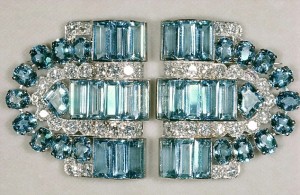
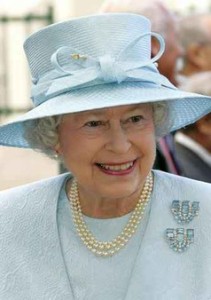
Cullinan Brooches
The famous and massive Cullinan diamond that was acquired by the British Crown in 1910 was cut into multiple pieces. The largest cut, the Cullinan I diamond, is set in the Sovereign’s Sceptre which is part of the British Royal Coronation Regalia. The Cullinan II is set into the Imperial State Crown. (For more information, please click on the links Crown Jewels of England Part One & Part Two)
Cullinan V Heart Brooch –
The Cullinan V is an 18.8 carat heart-shaped diamond featured in a beautiful platinum setting with a pave border of smaller diamonds. Queen Mary wore the Cullinan V Heart Brooch as the center section of the stomacher (in “royal terms” it is a decorative jeweled piece that is attached to the front bodice of a gown) which was part of the diamond and emerald parure she wore for the Delhi Durbar in 1911. Queen Mary also frequently wore the Cullinan VII pendant attached to the Cullinan VII brooch to form a large stomacher.
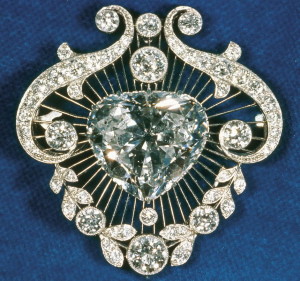
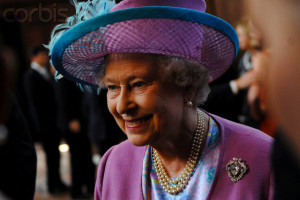
Cullinan VII and Cullinan VIII Brooch –
The Cullinan VII is an 11.5 carat marquise cut diamond set as a pendant and the Cullinan VIII is an 6.8 emerald-cut diamond mounted in the center of a platinum setting with a pave border of smaller diamonds. Even though Queen Elizabeth inherited the brooch in 1953, she has rarely worn it in public.
For more information about the other pieces in the Queen’s personal collection, please clink on the link The Queen’s Jewelry Collection Part One.
Also, if you are interested in more information about the Royal Family and their jewels, please click on the links to the following posts: The Crown Jewels (Part One and Part Two) and the Cambridge Emeralds.

